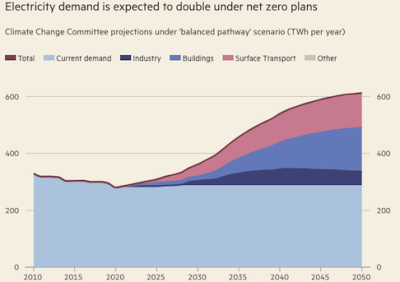
Retired film-maker Christopher Hamblin is unmoved at the prospect of a lump-sum payment from developers to compensate him for electricity towers and cables they want to build near his village in the east of England.
“That’s the trouble with these guys — they know the price of everything and the value of nothing,” says the 86-year-old resident of Ardleigh in Essex, a centuries-old settlement surrounded by some of the country’s most recognisable landscapes.
Hamblin and his fellow residents are part of a growing backlash in local communities across Britain against the expansion of power grids as the steps needed to decarbonise the economy start to encroach on them.
In an attempt to counter this resistance Nick Winser, the government’s electricity networks commissioner, has recommended lump-sum payments to households living close to proposed transmission lines. It was one of several measures aimed at cutting in half the 14 years it takes to complete these projects.
The government wants to decarbonise the electricity sector by 2035, while demand for electricity is expected to double or treble as the economy moves away from fossil fuels under its legally binding target of net zero carbon emissions by 2050. Electric Vehicles and AI data centres have added a crushing new burden.
The offer of cash for pylons (as towers are named in the UK) has not changed the mood in Ardleigh, which is in the path of a new 183km north-south high voltage transmission line that National Grid wants to build through the East Anglian countryside. It would run from Norwich in Norfolk down to Tilbury in Essex and bring in renewable electricity generated from new offshore wind farms.
It is one of several new electricity transmission lines being planned around Britain to move clean electricity often generated in remote coastal locations into more populated areas where it is needed.
The East Anglia plan mainly involves cables carried on 50m-tall pylons dotted across the countryside, including around Ardleigh, which sits on the edge of the protected countryside of Dedham Vale, made famous in the 19th-century masterpieces by local artist John Constable.
The reason for the opposition varies, ranging from blighting the landscape to the impact on farmers or health, but most opponents would rather see the power lines replaced by undersea cables running from the wind farms most of the way down to Tilbury.
“Every single house within that location — we will be in a cage of electricity pylons,” says Chris Whitfield, chair of Ardleigh parish council, pointing out part of the proposed route on a map.
Campaigners are well-organised, learning from other groups across the country, and are prepared to resort to legal action.
Local farm owner Charles Tritton suggested the anger is such that it could hurt the Tory party electorally. “The whole of East Anglia is pretty Conservative,” he said. “Add one or two per cent [swing vote] due to this and you know, goodbye Conservatives in East Anglia.”
Prominent local Conservative MPs have taken up the cause. On a visit to Ardleigh, Sir Bernard Jenkin, the outgoing Conservative MP, said undersea cables were the solution. “We’re all in favour of offshore wind [but] this is going to be mired in judicial review . . . they ought to short circuit and go back to the drawing board.”
Priti Patel, a former home secretary and the MP for Witham further south in Essex along the route of the proposed line to Tilbury, also backs a switch to undersea cables. “The offer of cash bribes shows that there is little interest in there being genuine engagement with communities to influence and improve infrastructure plans,” she said.
But running cables offshore, or burying them as some residents have called for, is expensive and developers are under pressure to keep costs down.
National Grid said its network upgrade was “needed urgently” but it was “giving careful consideration to environmental and community impacts, and to all the feedback we’re receiving.”
Lorna Holland, from Strathpeffer in northern Scotland, is similarly unmoved by the prospect of compensation from SSE, the developer of a proposed 167km power line using 57m high electricity pylons.
“I can’t see it making any real difference,” she said, adding: “I don’t want to sound like a complete nimby but it’s a difficult issue. I do understand we need these things and they have to go somewhere. But the whole approach has to be more measured.”
Rob McDonald, managing director of SSEN Transmission, said the upgrades were needed to meet clean energy targets but exact routes were not yet decided. He added the developer was “actively considering alternative options to electricity pylons following consultation with communities”.
In southern Wales, people are similarly upset. “I’ve never seen so many ashen-faced and angry people,” said Sarah Edwards, from Llandovery, describing the reaction when local residents heard of plans by Bute Energy for a 90km long power line on 27m-high electricity pylons.
The town, which sits on the proposed route, is on the edge of Brecon Beacons national park. Gareth Williams, grid director at Bute Energy, said the company was taking on board feedback from local residents and has “tried to design the project as sensitively as possible”.
Back in Ardleigh, Whitfield still hopes National Grid will change its plans after local consultations as he highlighted the effect the schemes could have on mental health. “It does damage people — you can’t get it out of your head: you drive around the countryside and think, we are going to lose that.”
NOW READ: https://off-grid.net/gridlock-for-uk-renewable-electricity/
